by Fe Marshment, Daniel Smithwick, and Melvin LaPrade
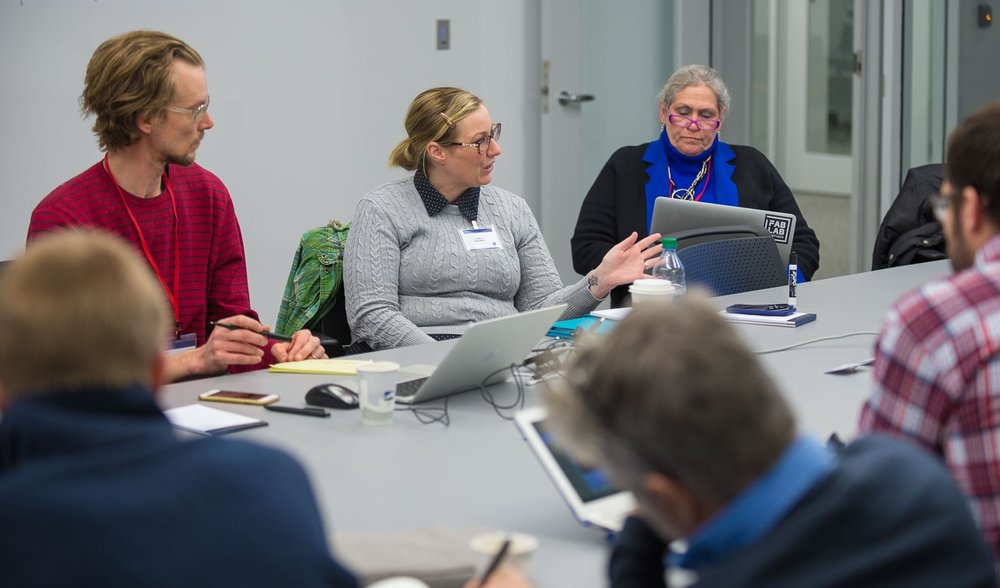
Photo © Stan Rowin stanstudio.com
I sat at the back of the SolidWorks 3D Experience Lab in Waltham, Massachusetts and watched as an oversized laser cutter engraved snowflakes into a thin sheet of metal. Flames ignited as a tiny laser beam cut its way into the molten metal that was flat on the grid. Next to this, I sat with my group. We struggled with the small Epilog laser cutter that was a quarter of the size, fighting with the right measurements to be able to cut a flattened cube into a thick piece of card stock. SCOPES-DF Master Fabricator, Daniel Smithwick, and SCOPES-DF consultant educator, Melvin LaPrade sat to my left. Melvin, absorbing the process, and Dan, tinkering with the laser settings, understanding what all master fabricators know – every machine is different and has a mind of its own. Just like students, we had to find an entry point to connect as a group before we could begin working together.
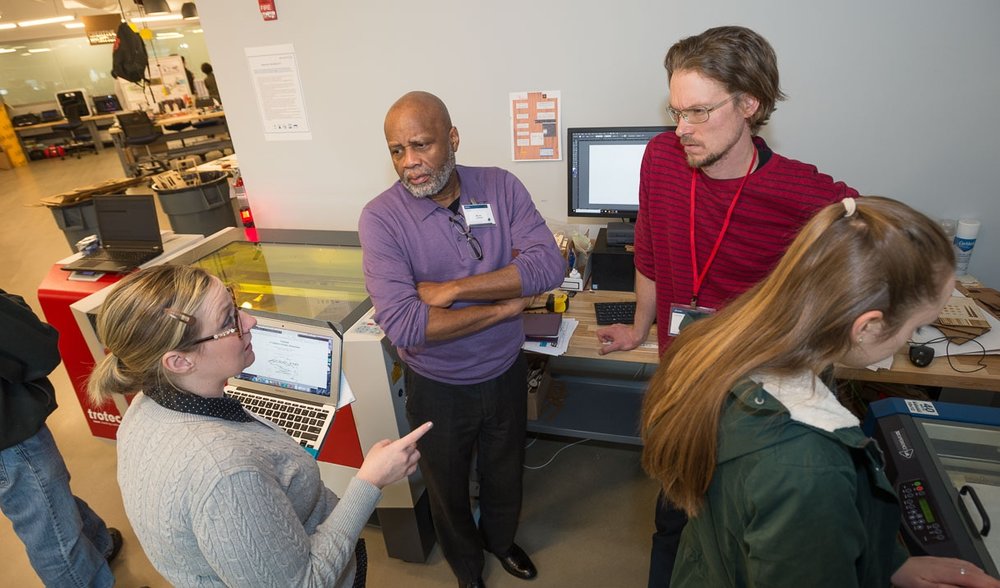
Photo © Stan Rowin stanstudio.com
OUR TASK AT HAND
We were given a task: remix a lesson that had been taught hundreds of times and bring it into the world of digital fabrication. Why? Simple: the world is changing. Google is at our fingertips. We don’t have to memorize facts, nor should we. With immediate access to most content, the process becomes the most important factor in learning. Additionally, we know a few truths about our students: they must be engaged, they must be active, they must have the opportunity to learn with their hands. We also know that there is still a value in coaching and teaching and we don’t need anyone to throw the baby out with the bathwater. There are incredible educational processes and lessons the students have learned from and teachers have loved teaching. This task was not about creating something new, but rather, reimagining learning for the real world that we live in right now.
We began the process by “unmasking” a lesson from the SCOPES-DF website – Mask Making – that was created by one of our contributing community members. We gathered as educators and fabricators alike to re-imagine and maximize a traditional lesson about the Phantom of the Opera and the symbolic nature of the mask worn throughout the play. They lesson was originally designed for 5th and 6th graders and it followed a pretty linear path: Read the Play – Make the Mask – See the Play – Done. While the linear model of education works in some instances, there are ways to enhance the lessons being taught. There is a very distinctive opportunity to integrate digital fabrication as a way to connect the singular subject of english language arts with mathematics, history, science, and engineering. Embedding digital fabrication into a traditional lesson unlocked doors for cohesion among disciplines and skill sets that students weren’t previously able to access. After all, nobody goes to work and spends an hour on an isolated task that be completed linearly; we go to work not knowing what the day will hold and fully understanding that we will encounter an unpredictable multitude of challenges.
THE WHY, WHAT, AND HOW?
After a few minutes of unmasking, our think tank took action. We all started throwing out ideas. Students could act out the play! Students could 3D print their own costumes! Students could re-design stage sets! Students could code robots to play the roles. Students could code the melodies to this musical story line. Our brains were full and we were now firing faster than the laser cutter. It was time to discuss and time to align.
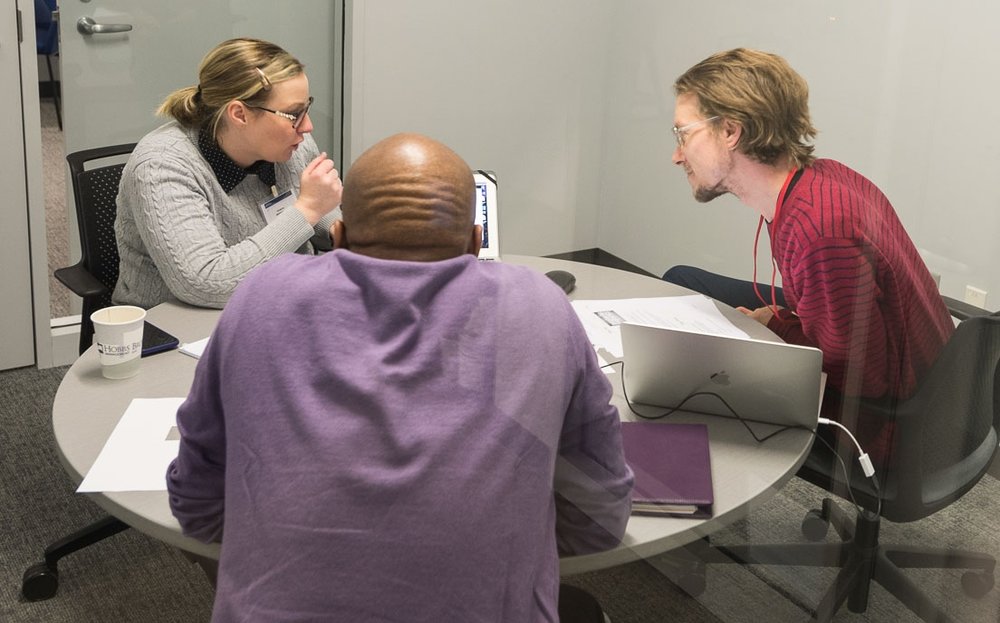
Photo © Stan Rowin stanstudio.com
Melvin discussed the why. Why did he teach this? Why does the classroom matter? Why do we need to understand the “whole student?” Dan began talking about the what. What are we capable of making? What are the functions of digital fabrication? What are the tools our students are armed with? As for me, I began laying out the how. How do we get from linear thinking to iterative thinking? How do we merge the digital fabrication skillsets with the academic skillsets in such a way that it would be fully embedded and not in addition to? How do we ensure students are learning what we need them to learn? Through our exploration of the why, what, and how, we mapped out an opportunity to enhance our lesson.
INTEGRATING THEATRE, ELA, GEOMETRY VIA DIGITAL FABRICATION
Stage One: Research
Theatre: Students watch Phantom of the Opera
- Students discuss characterization and character archetypes in Phantom of the Opera
- Students discuss why the Phantom chooses to wear his mask (mask symbolism)
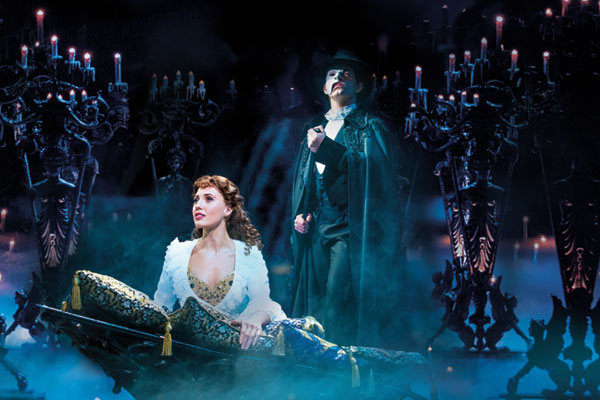
Phantom of the Opera, Her Majesty’s Theatre, London. Image from: https://www.londontheatredirect.com/musical/13/phantom-of-the-opera-tickets.aspx
English Language Arts: Students read Flatland: A Romance of Many Dimensions.
- Students discuss characterization and character archetypes in Flatland
- Students compare and contract the Phantom characters to the Flatland characters (and the genre of “romance in general.”
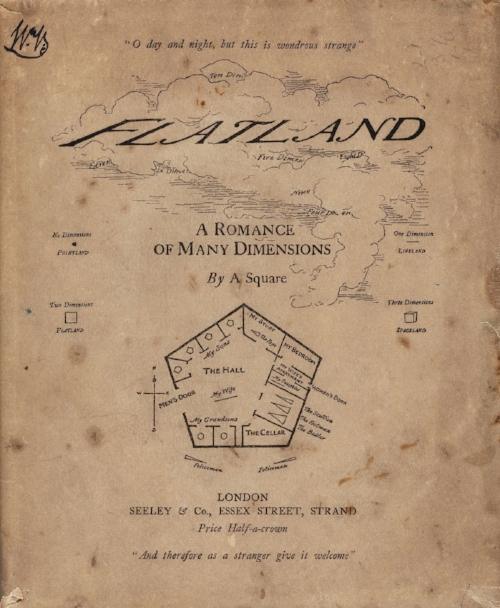
Flatland, by Edwin Abbott, 1884 – Original cover art. Image from https://en.wikipedia.org/wiki/Flatland
Geometry: Students learn about 2D and 3D shapes, beginning with the basics:
- Regular polygons – 2D shapes constructed from equal length sides and equal interior angles.
- Platonic solids – 3D shapes constructed from congruent regular polygons with an equal number of faces joining at each vertex. See: http://mathworld.wolfram.com/PlatonicSolid.html

The first 6 regular polygons with side counts and interior angles indentified.
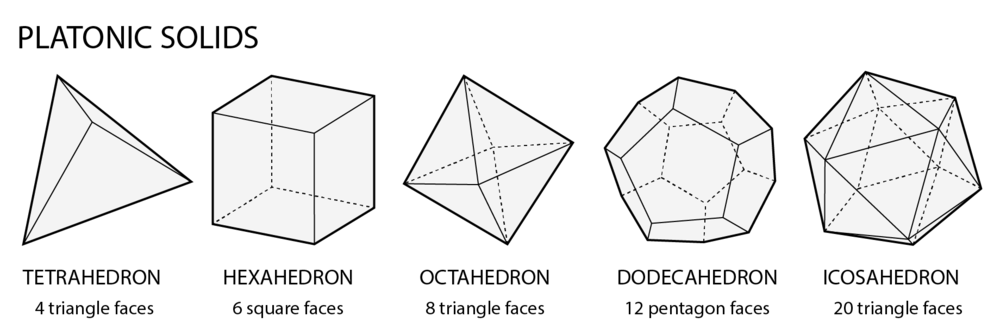
The 5 platonic solids with face shapes and counts identified.
Fab Activity: Students explore relationship between platonic shapes and regular polygons by cutting, folding, and unfolding paper shapes using 2D vector CAD tools and a laser cutter.
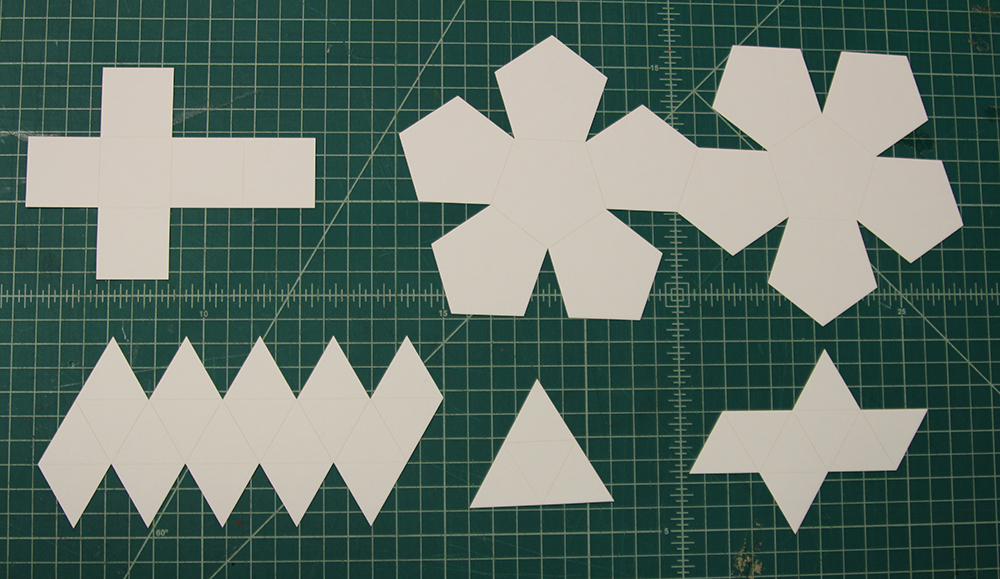
Laser cut platonic solids with scored grooves for easy folding, laid flat.
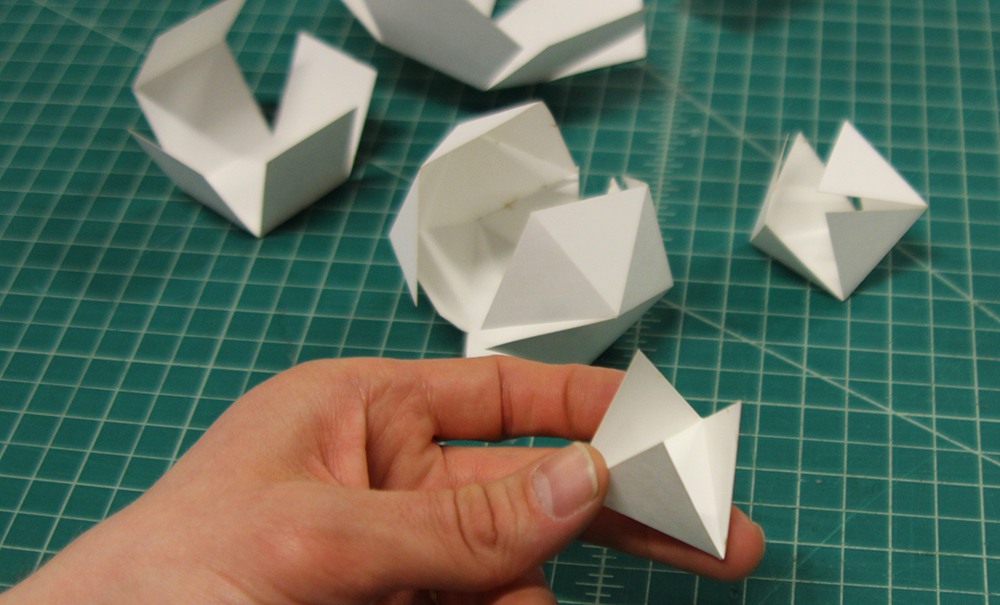
Laser cut platonic solids, folding in process.
Stage Two: Action!
Theatre: Students act out character archetypes as platonic shape metaphors
- Students view a live showing of Phantom of the Opera.
- Discuss how in the real world, people tend to be more than one platonic shape (a combination of all).
English Language Arts:
- Students decide on who their character archetype would be based on the shapes and characters from Phantom and Flatland
Geometry: Students explore shape combinations graphically using 2D vector software.
- Students learn about angles of rotation
- Students learn about scale and reflective transformations
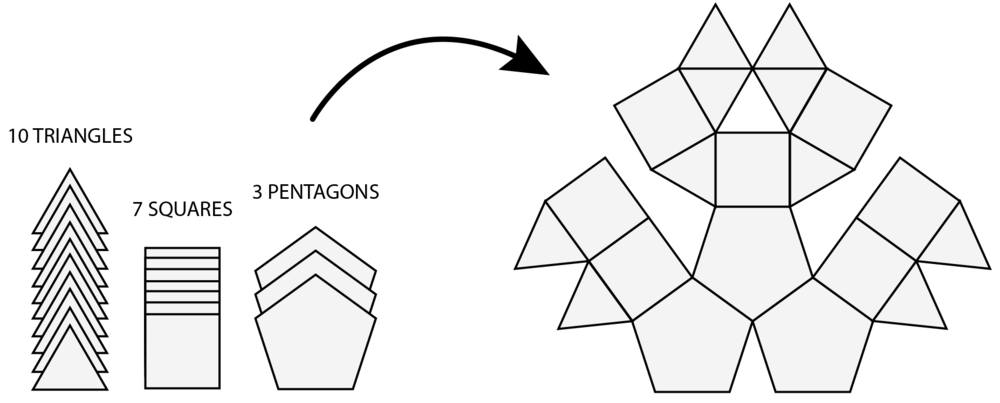
Combinations of the first three regular polygons can produce numerous shapes.
Fab Activity: Students decide which shapes would make-up their personal mask. Students design masks digitally through combining shapes to understand how different combinations of triangles, squares, and pentagons fold into 3 dimensional volumes. Students fabricate their mask shapes and assemble their laser cut shapes as wearable masks. Students present their masks.

The first prototype based on initial exploration of combining shapes.

Three mask iterations were created to improve volumetric features and reduce paper distortions.
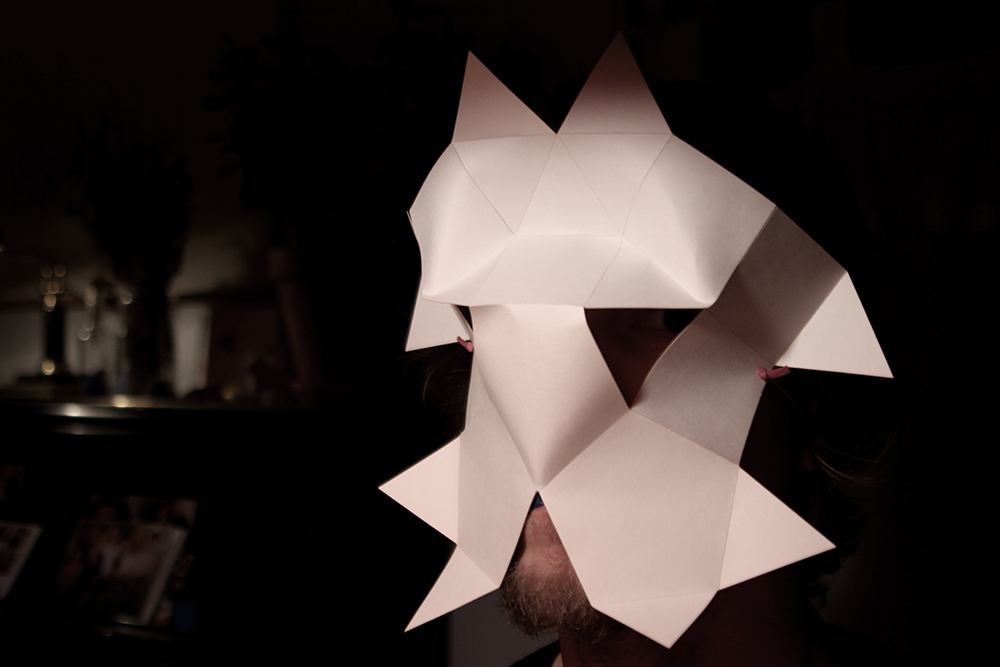
In the right light, the mask is pretty scary!
Stage Three: Reflective Questions
- Why is it important to know what type of mask you are wearing?
- Why is it important to know what types of “masks” others are wearing?
- Why is it important to understand platonic solids and how they fit together?
- Where might you use these skills in the future?
FEELING VULNERABLE BUT STEERING INTO THE CURVE
We mapped out our path in the limited time we were given for this exercise – about 1 hour. We spent a bit of time being uncomfortable and we spent a bit of time being constructive, but our ideas flowed and fired along side with the machines in the lab. There is something to be said of the workshopping process that we experienced. This experience is also felt by our students; one that forces them and us to be critical and vulnerable. When we worked together, we had that experience and we were willing to do so because we understood the outcome would be better than if we didn’t.
The uncomfortable feeling led me to some distinctive realizations about our project. First, digital fabrication is here to stay and it is only getting bigger and more expansive. My 10th grade driver’s ed. instructor told me once, “if you hit a patch of ice, don’t fight it, steer into the curve.” This is where education in the K-12 space should be going. Second, we couldn’t have reached this point without tapping into the unique talents of the larger community. Like a grassroots effort for change, we must seek each other out and build from each other’s talents to turn good to great. And third, what our community develops must be scalable and replicable so we don’t have to start from the beginning, but rather, build on each other’s successes. Now is the right time for the SCOPES-DF project. We are on the precipice of a new generation of learners and workers and industry and it’s time for all of us to “steer into the curve.”
By the time we were done with this process, I was back at the giant laser. The fire was still blazing and the snowflakes were still being etched into the metal. The hypnotic glow of the burn didn’t was no longer a distraction, it was simply the background noise. We had remixed and reimagined in a way that made digital fabrication relevant for the kids we would teach and allow them to gain process and practice skills, instead of just content. That’s what we were meant to do. That’s why we are here. I can’t wait to figure out our next steps!
Tagged: 2D + 3D Thinking, Flatland, Phantom of the Opera
